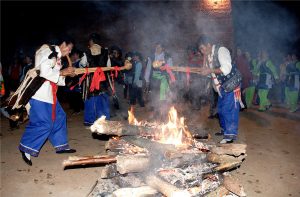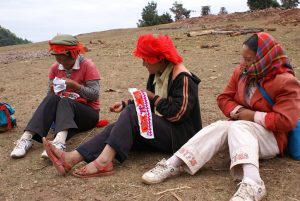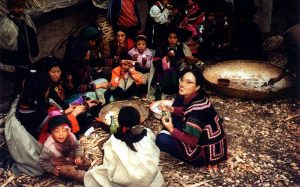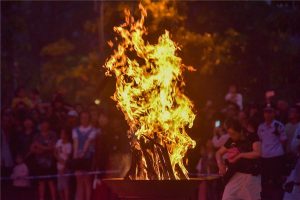
Conditions in the Past about Yi Ethnic Minority
Socio-economic development in the Yi areas was lopsided before liberation, due to oppression and exploitation by the reactionary ruling class, as well as historical and geographical differences. The socio-economic structure fell by and large into two types — feudalism and slavery. Most of the Yis in Yunnan, Guizhou and Guangxi had entered feudal society earlier on, and a developed landlord economy had emerged in most areas except for remnants of the manorial economy in some areas of northeastern Yunnan and northwestern Guizhou. Certain elements of capitalism had appeared in the Yi areas along the Yunnan-Vietnam Railway and the Gejiu-Bisezhai-Shiping Railway. Slavery remained intact for a long time in the Greater Liangshan Mountain area in Sichuan and the Lesser Liangshan Mountain area in Yunnan.
The Yi people in Yunnan, Guizhou and Guangxi, who were under feudal rule, were mainly engaged in agriculture and animal husbandry. The growth of handicraft industries and commerce varied from place to place. Generally speaking, the production level of Yis living near cities and towns was approximate to that of local Hans, but was much lower in mountain areas.

Landlords accounted for 5 per cent of the population in those areas, and poor peasants and farmhands 60 to 80 per cent. The land possessed by landlords was on the average 10 times or several dozen times the amount owned by poor peasants, who were subjected to cruel feudal exploitation. Land rent paid in kind reached 60 to 70 per cent of the harvest and tenants had to bear heavy corvee and miscellaneous levies.
Though the system of appointing hereditary headmen in northeastern Yunnan and northwestern Guizhou was abolished in the Qing Dynasty, some local tyrants, until liberation in 1949, used political power and influence in their hands to bully and exploit peasants as slave owners did, treating poor peasants as serfs.
Slavery kept production at an extremely low level for a long time in the Greater and Lesser Liangshan Mountain areas in Sichuan and Yunnan. While agriculture was the main line of production, land lay waste and production declined strikingly. Slash-and-burn cultivation was still practiced in some mountain areas. The lack of irrigation facilities and adequate manure, coupled with heavy soil erosion, lowered average grain output to less than a ton per hectare. Animal husbandry was a major sideline with sheep making up a large part of the livestock. The rate of propagation was very low due to extensive grazing and management.

For many centuries, barter was the form of trading among the Yis in the Liangshan Mountain areas. Goods for exchange mainly included livestock and grain. Salt, cloth, hardware, needles and threads and other daily necessities were available only in places where Yis and Hans lived together. Occasionally, some Han merchants, guaranteed safe-conduct by Yi headmen, carried goods into the Liangshan Mountain areas. At the risk of being captured and turned into slaves, they went and often made a net profit of more than 100 per cent. Suffering from a severe shortage of means of production and of subsistence, the Yis had to endure heavy exploitation in order to get a little essential goods. One hen was worth only a needle, and a sheepskin only a handful of salt. Many slaves had to go without salt all the year round.
Due to complex historical reasons, the slave system of the Yis in the Liangshan Mountains lasted till 1949.
Before 1949, the Yis in the Liangshan Mountain areas were stratified into four different ranks — “Nuohuo,” “Qunuo,” “Ajia” and “Xiaxi.” The demarcation between the masters and the slaves was insurmountable. The rank of “Nuohuo” was determined by blood lineage and remained permanent, the other ranks could never move up to the position of rulers.
“Nuohuo,” meaning “black Yi,” was the highest rank of society. Being the slave-owning class, Nuohuo made up 7 per cent of the total population. The black Yis controlled people of the other three ranks to varying degrees, and owned 60 to 70 per cent of the arable land and a large amount of other means of production. The black Yis were born aristocrats, claiming their blood to be “noble” and “pure,” and forbidding marriages with people of the other three ranks. They despised physical labour, lived by exploiting the other ranks and ruled the slaves by force.

“Qunuo,” meaning “white Yi,” was the highest rank of the ruled and made up 50 per cent of the population. This rank was an appendage to the black Yis personally and, as subjects under the slave system, they enjoyed relative independence economically and could control “Ajia” and “Xiaxi” who were inferior to them. “Qunuo” lived within the areas governed by the black Yi slave owners, had no freedom of migration, nor could they leave the areas without the permission of their masters. They had no complete right of ownership when disposing of their own property, but were subjected to restrictions by their masters. They had to pay some fees to their masters when they wanted to sell their land. The property of a dead person who had no offspring went to his master. Though the black Yi slave owners could not kill, sell or buy Qunuo at will, they could transfer or present as a gift the power of control over Qunuo. They could even give away Qunuo as the compensation for persons they had killed and use Qunuo as stakes. So, Qunuo had no complete personality of their own, though they were not slaves.
“Ajia” made up one third of the population, being rigidly bound to black Yi or Qunuo slaveowners, who could freely sell, buy and kill them.
“Xiaxi” was the lowest rank, accounting for 10 per cent of the population. They had no property, personal rights or freedom, and were regarded as “talking tools.” They lived in damp and dark corners in their masters’ houses, and at night had to curl up with domestic animal to keep warm. Supervised by masters, Xiaxi did heavy housework and farm work all the year round. They wore rags and tattered sheepskins, and lived on wild roots and leftovers. Slave owners inflicted all sorts of torture on those who were rebellious, fettered them with iron chains and wooden shackles to prevent them from escaping. Like domestic animals, Xiaxi could be freely disposed of as chattels, ordered about, insulted, beaten up, bought and sold, or killed as sacrifices to gods.

Corvee was the basic form of exploitation by the slave owners. Qunuo and Ajia must use their own cattle and tools to cultivate their masters’ land. Qunuo had to perform five, six or more than 10 days of corvee each year. They could send their slaves to do it or pay a sum of money instead. Corvee performed by Ajia took up one third to one half of their total working time. They often had to neglect their own land because of cultivating the land of their masters. Besides corvee, Qunuo and Ajia had to take usurious loans imposed by their black Yi masters.
Ordered about to toil like beasts of burden, the slaves had no interest in production at all. To win freedom, slaves in the Liangshan Mountain areas resorted to measures like going slow, destroying tools, maltreating animal, burning their masters’ property and even committing suicidal attacks on their masters. Though it was hard for slaves in remote mountain areas to run away, they still tried to escape at the risk of their lives. Spontaneous and sporadic rebellions staged by slaves against slave owners never ceased. Organized and collective struggle for personal rights also grew, and collective anathema often turned into small armed insurgence.

 7 Days GolfingTour
7 Days GolfingTour
 8 Days Group Tour
8 Days Group Tour
 8 Days Yunnan Tour
8 Days Yunnan Tour
 7 Days Shangri La Hiking
7 Days Shangri La Hiking
 11 Days Yunnan Tour
11 Days Yunnan Tour
 6 Days Yuanyang Terraces
6 Days Yuanyang Terraces
 11 Days Yunnan Tour
11 Days Yunnan Tour
 8 Days South Yunnan
8 Days South Yunnan
 7 Days Tea Tour
7 Days Tea Tour
 8 Days Muslim Tour
8 Days Muslim Tour
 12 Days Self-Driving
12 Days Self-Driving
 4 Days Haba Climbing
4 Days Haba Climbing
 Tiger Leaping Gorge
Tiger Leaping Gorge
 Stone Forest
Stone Forest
 Yunnan-Tibet
Yunnan-Tibet
 Hani Rice Terraces
Hani Rice Terraces
 Kunming
Kunming
 Lijiang
Lijiang
 Shangri-la
Shangri-la
 Dali
Dali
 XishuangBanna
XishuangBanna
 Honghe
Honghe
 Kunming
Kunming
 Lijiang
Lijiang
 Shangri-la
Shangri-la
 Yuanyang Rice Terraces
Yuanyang Rice Terraces
 Nujiang
Nujiang
 XishuangBanna
XishuangBanna
 Spring City Golf
Spring City Golf
 Snow Mountain Golf
Snow Mountain Golf
 Stone Mountain Golf
Stone Mountain Golf













